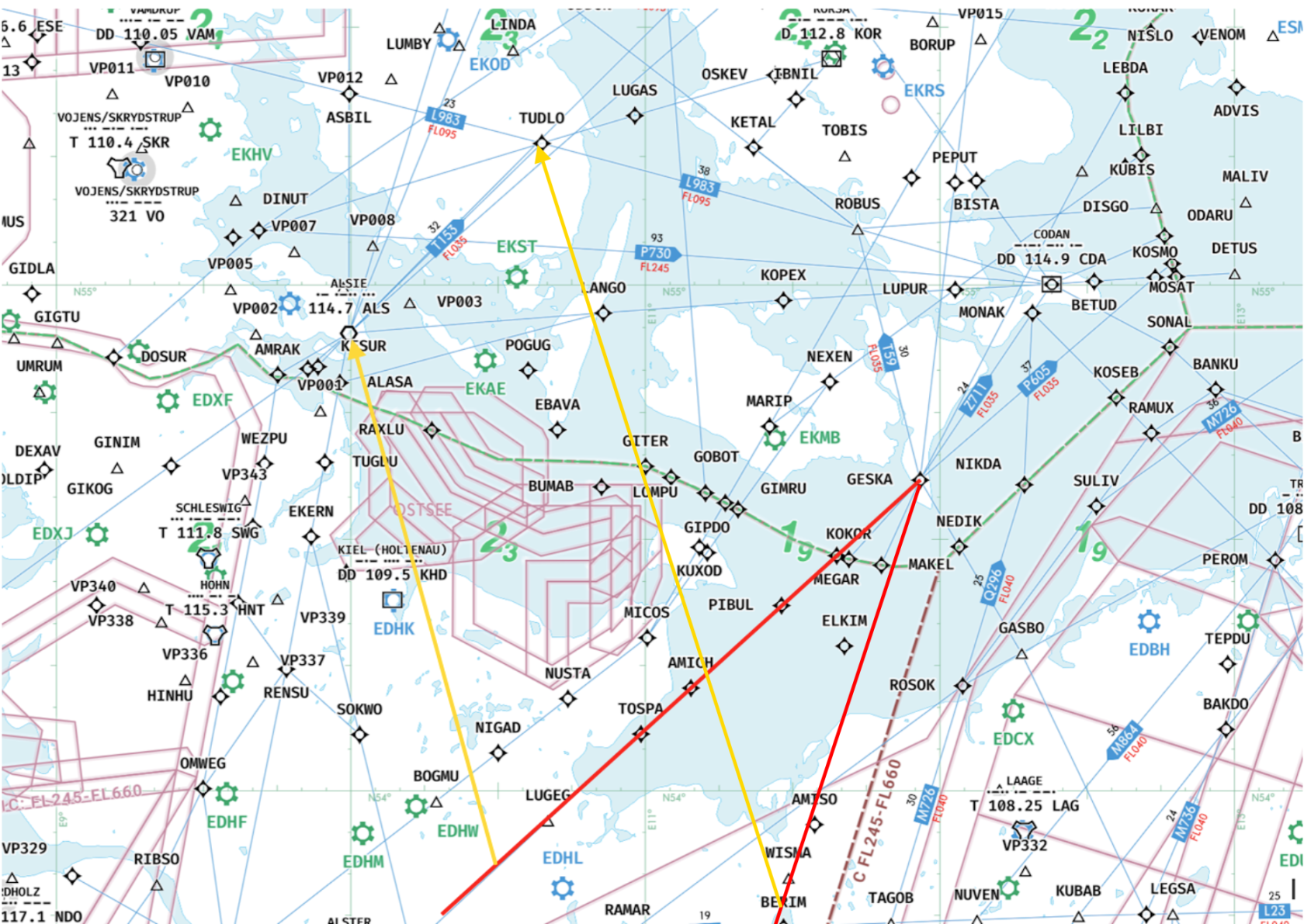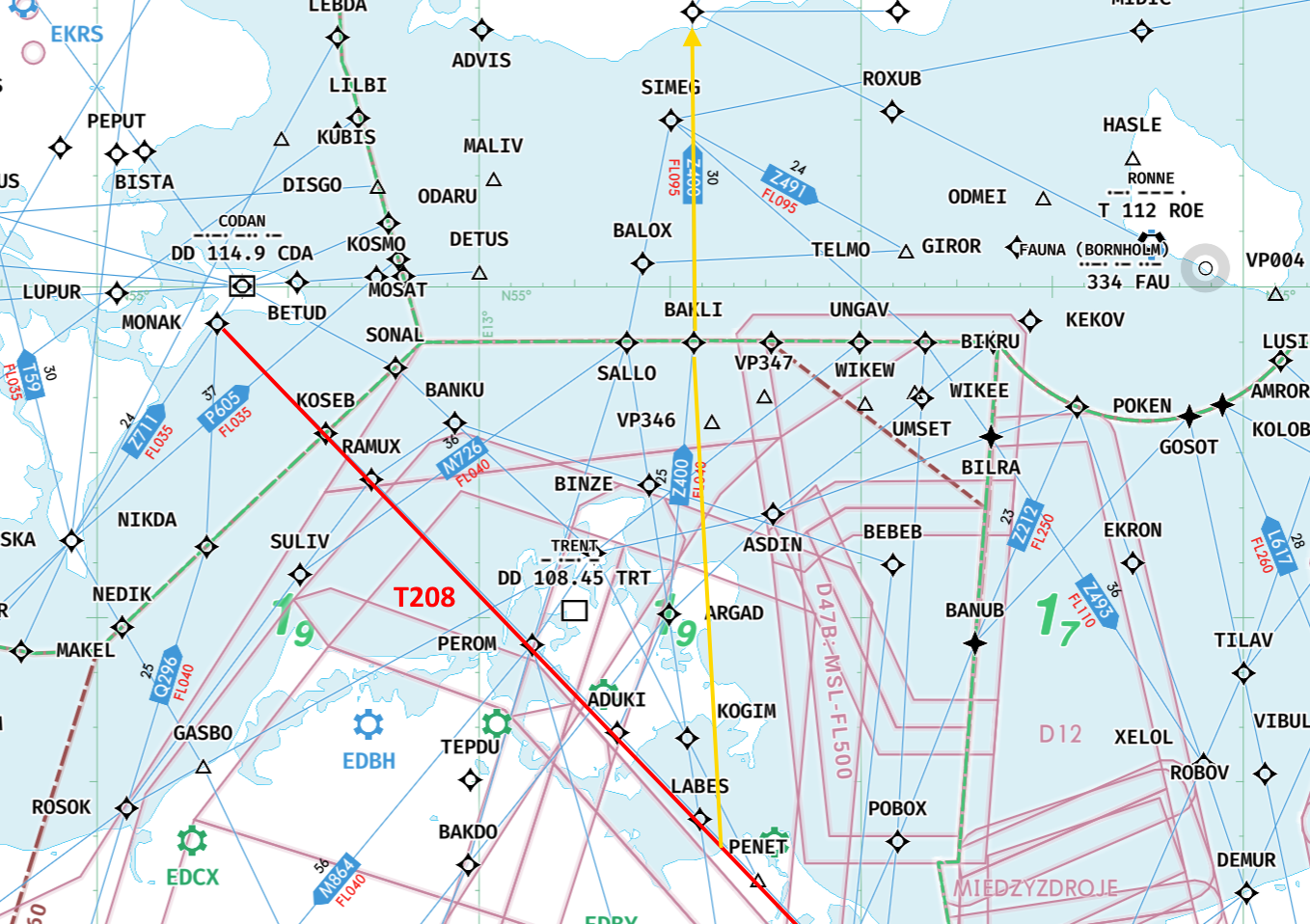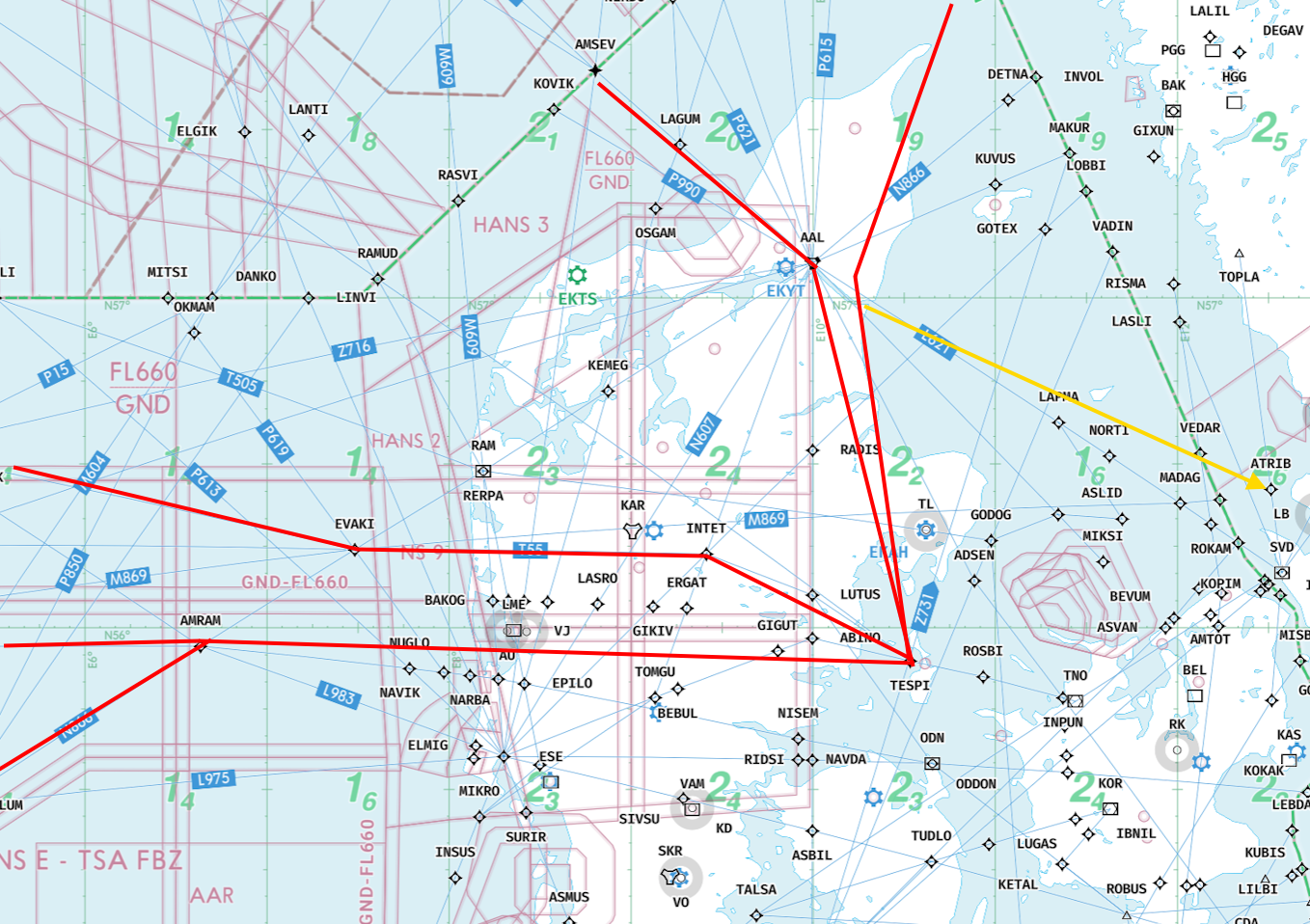Upper ACC / ACC Planner
This section is about the responsibility of ACC planners
All UPPER ACCs are ACC Planners
EKDK_A_CTR
Planner for EKDK_B_CTR
1 General
1.1 Responsibilities
Sitting on EKDK_A_CTR you have are generally responsible for climbs to NEXEN, and enroute traffic in Sector A/UA. While you have quite little traffic load your responsibility is heavy as you need to coordinate and plan traffic into the Brave sector. Something which is quite demanding
1.2 Sector Ownership
With EKDK_C_CTR online you may be advised to take Hybrid sector EKDK_A_CTR which gives you responsibility of EKDK_I_CTR to handle departures.
In case of arrivals above FL285 you are in charge of the holding.
2. Arrivals
Always have close coorperation with your Active ACC Sector (EKDK_B_CTR) and Flow Manager (EKDK_FMP)
2.1 General
Handling of arrivals are of significant important with emphasis on following situations
- Stacking of arrivals to FL270 from Muritz to avoid LOS
- Re-Routing of EDYY arrivals as needed to avoid stacked holdings.
- Re-Routing of DWM arrivals far east via BAKLI-TIDVU
- Establish secondary holds at MEGAR and coordinate sequence.
- When holding established above FL280
- EDDH arrivals af FL230
2.2 Stacking for DWM
When you see flights from DWM at FL200 to MONAK starts getting difficult, stacking up to and including FL270 needs to be in effect. In that case contact EDWW_M_CTR and advise aircraft callsign and level. if flights are still at cruise level you may be able to do it directly via the TAG.
If you decide to stack flights above FL270 you will need to establish secondary holdings fro EDYY/EDWW arrivals
Note that en-route holdings at NIKDA and KOSEB are NOT allowed due to proximity of OLPIB hold
2.3 Secondary holding at MEGAR
Flights from EDDH at FL230, and flights from EDYY when holding is stacked above FL280 is crucial. In this case you shall coordinate with EKDK_B_CTR to re-clear and hold at point "MEGAR". This will ensure clearance to OLPIB without busting EDWW/EDYY airspace.
You can choose to coordinate with EKDK_B or ask for the flights yourself to manage that holding.
At no times should more that ~10 aircraft be in OLPIB hold. If so, keep them on your frequency and hold them until load decrease at OLPIB.
When aircraft are holding at MEGAR, you MUST note and communicate to EKDK_B_CTR where in the sequence they fit in. Effectively this can be done by "Highlighting" the aircraft in OLPIB hold the aircraft in MEGAR hold will be Preceeding. This allows EKDK_B to keep a hole in the holding at the level of the MEGAR hold, and then squeeze that aircraft into OLPIB hold when his turn in sequence as come.
2.4 Re-Routings
All Re-Routings MUST happen in communication with Flow Manager FMP
Re-Routing MAY also be directed by Flow Manager FMP
Re-Routings normally are either:
It is prohibited to execute these re-routings without the clear consent from EKDK_FMP (if online)
EKDK_C_CTR
Planner for EKDK_D_CTR
1 General
1.1 Responsibilities
Sitting on EKDK_C_CTR you have are generally responsible for climbs to LANGO, and enroute traffic in Sector C/UC.
1.2 Sector Ownership
With EKDK_D_CTR NOT online you may be advised to take Hybrid sector EKDK_C_CTR which gives you responsibility of EKDK_D_CTR to handle TUDLO arrivals all the way down.
With EKDK_A_CTR is NOT online you will also be given responsibility of ACC Copenhagen Sector I.
In case of arrivals above FL285 you are in charge of the holding.
2. Arrivals
Always have close cooperation with your Active ACC Sector (EKDK_D_CTR) and Flow Manager (EKDK_FMP)
2.1 General
Handling of arrivals are of significant important with emphasis on following situations
- Ensure not more that ~8-10 aircraft are under control of EKDK_D_CTR
- At high traffic situations, "Pre-Clear" aircraft on arrival and into holdings"
- Stay at close contact and help you EKDK_D_CTR as you see fit
2.2 Holdings
It is vital that EKDK_D_CTR is not overloaded by holdings. ~8-10 aircraft is maximum that should be in EKDK_Ds holding at any time. In order to help him out, stand holdings in excess of 8-10 above FL280. If space above FL280 gets tight, descent aircraft into EKDK_D_CTRs airspace while keeping control, and handover an ad-hoc basis
Altitude in the holding is always LESS critical than amount of aircrafts on the frequency
2.3 Lower Holdings
If you can see that inbound traffic rush is imminent, coordinate with FMP to establish holds at TUDLO below FL130 down to a minimum to FL80
2.4 Secondary holding at TALSA
In very heavy traffic situations and situations where we close down EKCH airspace for arrivals introduce TALSA hold on "current inbound track" with Right turns, 1.5 minute legs.
Here you start stacking aircrafts as needed until they can be released into ACC Lower East
2.5 Re-Routings
All Re-Routings MUST happen in communication with Flow Manager FMP
Re-Routing MAY also be directed by Flow Manager FMP
No regular Re-Routings are used from EKDK_C_CTR, but on Ad-Hoc basis flights may be re-cleared to either TESPI or MONAK if traffic situation demands it.
It is prohibited to execute these re-routings without the clear consent from EKDK_FMP (if online)
EKDK_V_CTR
Planner for EKDK_D_CTR
1 General
1.1 Responsibilities
Sitting on EKDK_V_CTR you have are generally responsible for climbs to LANGO, and enroute traffic in Sector C/UC.
1.2 Sector Ownership
NIL
2. Arrivals
Always have close cooperation with your Active ACC Sector (EKDK_D_CTR) and Flow Manager (EKDK_FMP)
2.1 General
Handling of arrivals are of significant important with emphasis on following situations
- Ensure not more that ~8-10 aircraft are under control of EKDK_D_CTR
- At high traffic situations, "Pre-Clear" aircraft on arrival and into holdings"
- Stay at close contact and help you EKDK_E_CTR as you see fit
- Enforce Ground stop at EKBI, EKYT, EKAH, EKKA in coordination with FMP.
- If local ATC is online INFORM them on event start that all ATC clearances are subject to release by either you or EKDK_FMP (to be coordinated internally)
2.2 Holdings
It is vital that EKDK_E_CTR is not overloaded by holdings. ~8-10 aircraft is maximum that should be in EKDK_Es holding at any time. In order to help him out, stand holdings in excess of 8-10 above FL240. If space above FL240 gets tight, descent aircraft into EKDK_E_CTRs airspace while keeping control, and handover an ad-hoc basis
2.3 Lower Holdings
If you can see that inbound traffic rush is imminent, coordinate with FMP to establish holds at TESPI below FL130 down to a minimum to FL90
Altitude in the holding is always LESS critical than amount of aircrafts on the frequency
2.4 Secondary holding at AAL
Aircraft from ACC Polaris (ENOR, ENOS, ENSV)
In very heavy traffic situations and situations where we close down EKCH airspace for arrivals introduce AAL hold on "263 track" with Right turns, 1.5 minute legs.
Here you start stacking aircrafts as needed until they can be released into ACC Lower East
2.5 Secondary holding at BAVTA
Aircraft from ACC Scottish (EGPX)
In very heavy traffic situations and situations where we close down EKCH airspace for arrivals introduce BAVTA hold on "current inbound track" with Right turns, 1.5 minute legs.
Here you start stacking aircrafts as needed until they can be released into ACC Lower East
2.4 Re-Routings
All Re-Routings MUST happen in communication with Flow Manager FMP
Re-Routing MAY also be directed by Flow Manager FMP
On an Ad-Hoc basis aircraft can be re-routed from TESPI to TUDLO
It is prohibited to execute these re-routings without the clear consent from EKDK_FMP (if online)




